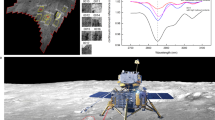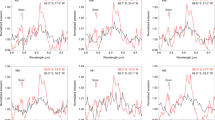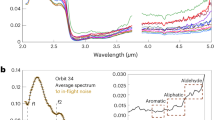Abstract
Remote sensing discoveries of hydroxyl and water on the lunar surface have reshaped our view of the distribution of water and related compounds on airless bodies such as the Moon1,2,3. The origin of this surface water is unclear4, but it has been suggested that hydroxyl in the lunar regolith can result from the implantation of hydrogen ions by the solar wind1,5. Here we present Fourier transform infrared spectroscopy and secondary ion mass spectrometry analyses of Apollo samples that reveal the presence of significant amounts of hydroxyl in glasses formed in the lunar regolith by micrometeorite impacts. Hydrogen isotope compositions of these glasses suggest that some of the observed hydroxyl is derived from solar wind sources. Our findings imply that ice in polar cold traps could contain hydrogen atoms ultimately derived from the solar wind, as predicted by early theoretical models of water stability on the lunar surface6. We suggest that a similar mechanism may contribute to hydroxyl on the surfaces of other airless terrestrial bodies where the solar wind directly interacts with the surface, such as Mercury and the asteroid 4-Vesta.
This is a preview of subscription content, access via your institution
Access options
Subscribe to this journal
Receive 12 print issues and online access
$259.00 per year
only $21.58 per issue
Buy this article
- Purchase on Springer Link
- Instant access to full article PDF
Prices may be subject to local taxes which are calculated during checkout



Similar content being viewed by others
References
Pieters, C. M. et al. Character and spatial distribution of OH/H2O on the surface of the Moon seen by M3 on Chandrayaan-1. Science 326, 568–572 (2009).
Sunshine, J. M. et al. Temporal and spatial variability of lunar hydration as observed by the deep impact spacecraft. Science 326, 565–568 (2009).
Clark, R. N. Detection of adsorbed water and hydroxyl on the Moon. Science 326, 562–564 (2009).
McCord, T. B. et al. Sources and physical processes responsible for OH/H2O in the lunar soil as revealed by the Moon mineralogy mapper (M3). J. Geophys. Res. 116, E00G05 (2011).
Ichimura, A. I., Zent, A. P., Quinn, R. C., Sanchez, M. R. & Taylor, L. A. Hydroxyl (OH) production on all airless planetary bodies: Evidence from H+/D+ ion-beam experiments. Earth Planet. Sci. Lett. 345, 90–94 (2012).
Watson, K., Murray, B. C. & Brown, H. The behavior of volatiles on the lunar surface. J. Geophys. Res. 66, 3033–3045 (1961).
Saal, A. E. et al. Volatile content of lunar volcanic glasses and the presence of water in the Moon’s interior. Nature 454, 192–196 (2008).
Boyce, J. W. et al. Lunar apatite with terrestrial volatile abundances. Nature 466, 466–469 (2010).
McCubbin, F. M. et al. Nominally hydrous magmatism on the Moon. Proc. Natl Acad. Sci. USA 107, 11223–11228 (2010).
Greenwood, J. P. et al. Hydrogen isotope ratios in lunar rocks indicate delivery of cometary water to the Moon. Nature Geosci. 4, 79–82 (2011).
Hauri, E. H., Weinreich, T., Saal, A. E., Rutherford, M. C. & Van Orman, J. A. High pre-eruptive water contents preserved in lunar melt inclusions. Science 333, 213–215 (2011).
Colaprete, A. et al. Detection of water in the LCROSS ejecta plume. Science 330, 463–468 (2010).
Feldman, W. C. et al. Evidence for water ice near the lunar poles. J. Geophys. Res. 106, 23231–23251 (2001).
Fegley, B. Jr & Swindle, T. D. Resources of Near-Earth Space 367–426 (1993).
Hiroi, T., Pieters, C. M. & Takeda, H. Grain size of the surface regolith of Asteroid 4 Vesta estimated from its reflectance spectrum in comparison with HED meteorites. Meteoritics 29, 394–396 (1994).
Keller, L. P. & McKay, D. S. The nature and origin of rims on lunar soil grains. Geochim. Cosmochim. Acta 61, 2331–2341 (1997).
Crider, D. H. & Vondrak, R. R. The solar wind as a possible source of lunar polar hydrogen deposits. J. Geophys. Res. 105, 26773–26782 (2000).
Taylor, L. A., Rossman, G. R. & Qu, Q. Where has all the lunar water gone? Lunar Planet. Sci. Conf. 26, abstr. 1399 (1995).
McKay, D. S. et al. Apollo 16 regolith breccias: Characterization and evidence for early formation in the mega-regolith. J. Geophys. Res. 91, D277–D303 (1986).
Taylor, L. A., Pieters, C. M., Keller, L. P., Morris, R. V. & McKay, D. S. Lunar mare soils: Space weathering and the major effects of surface-correlated nanophase Fe. J. Geophys. Res. 106, 27985–27999 (2001).
Epstein, S. & Taylor, H. P. O18/O16, Si30/Si28, D/H, and C13/C12 ratios in lunar samples. Proc. 2nd Lunar Sci. Conf. 2, 1421–1441 (1971).
Huss, G. R., Nagashima, K., Burnett, D. S., Jurewicz, A. J. G. & Olinger, C. T. A new upper limit on the D/H ratio in the solar wind. Lunar Planet. Sci. Conf. 43, abstr. 1709 (2012).
Saal, A. E., Hauri, E. H., Van Orman, J. A. & Rutherford, M. C. D/H ratios of the lunar volcanic glasses. Lunar Planet. Sci. Conf. 43, abstr. 1327 (2012).
Füri, E., Marty, B. & Assonov, S. S. Constraints on the flux of meteoritic and cometary water on the Moon from volatile element (N–Ar) analyses of single lunar soil grains, Luna 24 core. Icarus 218, 220–229 (2012).
McKay, D. S. et al. in Lunar Sourcebook (eds Heiken, G., Vaniman, D. & French, B.) (Cambridge Univ. Press, 1991).
Starukhina, L. Water detection on atmosphereless celestial bodies: Alternative explanations of the observations. J. Geophys. Res. 106, 14701–14710 (2001).
Robert, F., Gautier, D. & Dubrulle, B. The solar system D/H ratio: Observations and theories. Space Sci. Rev. 92, 201–224 (2000).
Hartogh, P et al. Ocean-like water in the Jupiter-family comet 103P/Hartley 2. Nature 478, 218–220 (2011).
Gopalan, K., Goswami, J. N., Rao, M. N., Suthar, K. M. & Venkatesan, T. R. Solar cosmic ray produced noble gases and tracks in lunar fines 10084 and 14163. Proc. Lunar Sci. Conf. 8, 793–811 (1977).
Housley, R. M., Grant, R. W. & Paton, N. E. Origin and characteristics of excess Fe metal in lunar glass welded aggregates. Geochim. Cosmochim. Acta 3 (Proc. 4th Lunar Sci. Conf., Suppl. 4), 2737–2749 (1973).
Acknowledgements
This work is supported in part by NASA Cosmochemistry grants NNX11AG58G (L.A.T.), NNX10AH74G (Y.Z.), the support from the Moore Foundation to the Caltech Microanalysis Center (J.M.E.), and NSF grant EAR-0947956 (G.R.R.). A portion of this study was also supported by the Planetary Geosciences Institute at UTK. We thank Z. Xu for her assistance with FTIR analyses at UM, M. L. Voyer for kindly providing glass standards, and J. Mosenfelder for providing the dry olivine standard.
Author information
Authors and Affiliations
Contributions
Y.L. led the project from the sample preparation, the FTIR and SIMS measurements, to the paper writing. Y.G. set up the SIMS instrument and assisted in the formulation of the analytical protocol. Y.Z. assisted in the infrared analyses for all agglutinates. G.R.R. assisted in the preliminary infrared analyses of three agglutinates. L.A.T. initialized the search for water in agglutinates with G.R.R. ∼20 yr ago, has championed this endeavor since, and was allocated the lunar soil samples by NASA. All authors participated in the data interpretation and paper writing.
Corresponding author
Ethics declarations
Competing interests
The authors declare no competing financial interests.
Supplementary information
Supplementary Information
Supplementary Information (PDF 2202 kb)
Rights and permissions
About this article
Cite this article
Liu, Y., Guan, Y., Zhang, Y. et al. Direct measurement of hydroxyl in the lunar regolith and the origin of lunar surface water. Nature Geosci 5, 779–782 (2012). https://doi.org/10.1038/ngeo1601
Received:
Accepted:
Published:
Issue Date:
DOI: https://doi.org/10.1038/ngeo1601
This article is cited by
-
Hydrogen-bearing vesicles in space weathered lunar calcium-phosphates
Communications Earth & Environment (2023)
-
A solar wind-derived water reservoir on the Moon hosted by impact glass beads
Nature Geoscience (2023)
-
Formation of lunar surface water associated with high-energy electrons in Earth’s magnetotail
Nature Astronomy (2023)
-
Evidence of water on the lunar surface from Chang’E-5 in-situ spectra and returned samples
Nature Communications (2022)
-
Chang’E-5 samples reveal high water content in lunar minerals
Nature Communications (2022)



